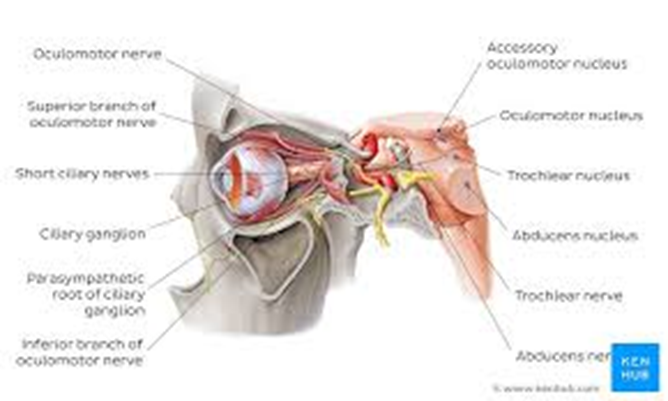The nurse read the patient's health history and noted cranial nerve III oculomotor paralysis. Which of the following would the nurse expect?

The eye cannot look to the outside.
Myopia.
Ptosis will be evident and no pupillary constriction.
Normal eye movement.
The Correct Answer is C
Choice a reason:
The inability of the eye to look outward, known as lateral rectus palsy, is associated with cranial nerve VI, the abducens nerve, not the oculomotor nerve. The oculomotor nerve does not control the lateral rectus muscle which governs this movement.
Choice b reason:
Myopia, or nearsightedness, is a refractive error of the eye where distant objects appear blurry while close objects can be seen clearly. It is not related to oculomotor nerve paralysis, which affects eye movements and pupil response, not the shape of the eyeball or the refractive properties of the lens.
Choice c reason:
Ptosis, or drooping of the upper eyelid, and an absence of pupillary constriction are classic signs of oculomotor nerve paralysis. The oculomotor nerve controls most of the eye's movements, including lifting the eyelid via the levator palpebrae superioris muscle and constricting the pupil through the circular muscles of the iris.
Choice d reason:
Normal eye movement would not be expected in a patient with oculomotor nerve paralysis. This nerve controls the majority of the eye's movements, so paralysis would lead to abnormal eye movement, such as the inability to move the eye upward, downward, or inward.
Nursing Test Bank
Naxlex Comprehensive Predictor Exams
Related Questions
Correct Answer is A
Explanation
Choice A reason:
The primary purpose of health assessment is to collect, analyze, and interpret data to identify the patient’s health status and needs, as well as to develop and implement appropriate nursing interventions to address these needs. It is a systematic process that is fundamental in promoting the health and well-being of patients. This involves a comprehensive evaluation of the patient's physical, psychological, and social health. Gathering this information is crucial for creating a care plan that addresses the individual needs of the client.
Choice B reason:
While health assessments can aid physicians in diagnosing illness, they are not solely for the purpose of diagnosis without further testing. Health assessments may indicate the need for additional tests to confirm a diagnosis. The nurse's role includes supporting the diagnostic process, but it is not the primary purpose of health assessment.
Choice C reason:
Health assessments are not meant to be subjective or based on the nurse's personal views and beliefs. The assessments are conducted to objectively determine the health status of a client, which then informs evidence-based practice and care planning. Personal biases should not influence the management of a client's illness.
Choice D reason:
Making judgments about a client's lifestyle and behaviors is not the primary purpose of health assessment. While lifestyle and behaviors may be assessed as part of understanding the client's overall health status, the goal is not to judge but to understand how these factors may impact the client's health and to provide education and support for healthy changes if needed.
Correct Answer is B
Explanation
Choice A reason:
Reddened intact skin is typically associated with a stage 1 pressure ulcer, where the skin is not yet broken but shows signs of redness. This stage indicates that the skin is under pressure and may be at risk for further breakdown if the pressure is not relieved.
Choice B reason:
A stage 3 pressure ulcer involves full-thickness skin loss that extends into the subcutaneous tissue layer but does not involve underlying muscle or bone. The ulcer presents as a deep crater, and there may be slough or eschar present. It is important to manage these ulcers carefully to prevent further deterioration and complications such as infection.
Choice C reason:
Skin loss involving up to the dermis layer is characteristic of a stage 2 pressure ulcer. In this stage, the epidermis and part of the dermis are lost, creating a shallow open wound or blister. This stage is less severe than stage 3 and requires different management strategies to promote healing and prevent progression.
Choice D reason:
Exposed bone is indicative of a stage 4 pressure ulcer, which is the most severe stage. It involves full-thickness skin loss with extensive destruction, possibly including muscle, tendon, or bone exposure. These ulcers are at high risk for serious infections, including osteomyelitis, and require aggressive medical and surgical intervention to heal.
Whether you are a student looking to ace your exams or a practicing nurse seeking to enhance your expertise , our nursing education contents will empower you with the confidence and competence to make a difference in the lives of patients and become a respected leader in the healthcare field.
Visit Naxlex, invest in your future and unlock endless possibilities with our unparalleled nursing education contents today
Report Wrong Answer on the Current Question
Do you disagree with the answer? If yes, what is your expected answer? Explain.
Kindly be descriptive with the issue you are facing.
